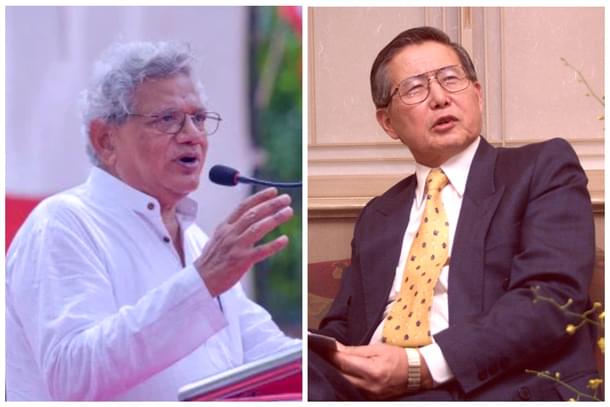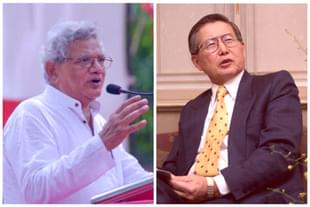Politics
Yechury And Fujimori: The Futile And The Efficacious
Prasenjit K Basu
Sep 14, 2024, 01:20 AM | Updated 01:20 AM IST
Save & read from anywhere!
Bookmark stories for easy access on any device or the Swarajya app.


Sitaram Yechury, general secretary (boss) of the Communist Party of India-Marxist (CPI-M) passed away on 12 September.
His death brought forth the usual outpouring of grief, particularly from the Congress ecosystem, which was particularly grateful to him for being a steadfast ally of the Nehruvian party (quite contrary to his predecessors, who had been instinctively anti-Congress).
In fact, SA Dange (now known to have been a double agent, with ties to both Soviet and British intelligence after independence) had been the only eminent Indian communist (along with articulate but minor figures like Mohit Sen) willing to align with Congress in the early decades – until the CPI received orders from Moscow to do so after 1969.
Even then, the CPI-M stayed aloof from Congress until Yechury changed its stance in 2004, despite leader Prakash Karat’s reservations.
A bright student (he topped the CBSE all-India merit list), Sitaram Yechury placed his atheism – and consequent antipathy towards Hinduism – above everything else. He went to JNU after obtaining an Economics degree from Delhi University’s St. Stephen’s College, became a student leader there, and was the first in the long line of JNU student leaders to make a smooth transition to party politics with the CPI-M.
Upon his passing, a photo quickly went viral, claiming that it showed him (as JNUSU president) presenting a written demand to “Prime Minister Indira Gandhi” to resign as Chancellor of JNU – in September 1977. The only problem with that claim, of course, was that she wasn’t PM (or even an MP) at the time, having lost her Rae Bareli seat in the March 1977 election.
The attempt at hagiography was rather tacky, since Yechury had anyway been a stalwart opponent of the Emergency (and such contortions were unnecessary to make that point). The event memorialised was rather less dramatic: an out-of-power Indira didn’t take long to cave into the demand, but the heroism the photo portrayed was grossly exaggerated.
During his 32 years in the Politburo of the CPI(M), Yechury presided over the decimation of his party. When he entered the politburo in January 1992, his party had 35 Lok Sabha (LS) seats and ruled three states. It still had nine Lok Sabha seats when he became the party boss in April 2015.
When he died (while still serving as the General Secretary of his party) it was down to four LS seats (two of them won as junior partner in Tamil Nadu, another in Rajasthan!) and was barely hanging on in Kerala, heading a coalition there but winning just a single LS seat.
Of his 12 years in the Rajya Sabha (2005-17), there is not a single legislative achievement to speak of, and no significant benefit to West Bengal, the state he represented.
The CPI-M finally withdrew its support to UPA-1 in 2008 over its continued opposition to the India-US nuclear pact. So Yechury’s party yet again acted against India’s national interest on an issue of paramount importance – with China working hard at the Nuclear Suppliers Group to maintain the regime of nuclear apartheid against India, which the Bush administration nonetheless dismantled.
When the Maoist leader Pushpa Kamal Dahal ‘Prachanda’ became the first Prime Minister of republican Nepal in 2008, Yechury is said to have used his links with Baburam Bhattarai (Prachanda’s sometime rival and colleague), a fellow JNU alumnus, to help India contact Prachanda. But Yechury did little with those personal ties to reduce the Nepal Maoists’ visceral hatred of India (encapsulated in demands to abrogate the Indo-Nepal treaty of 1950, under which India and Nepal allow completely free movement of goods, labour and capital between the two countries).
Sadly, Sitaram Yechury’s life was spent in continued pursuit of a failed ideology that has been rejected even in China since 1979. He has gone to meet his Marx, with a poor scorecard on earth.
A day earlier, 11 September, on the other side of the planet, Peru lost one of its most transformative leaders—Alberto Fujimori, a leader whose death resonates deeply.
During his decade in power, Fujimori made Peru an 'Asian Tiger in the Americas’, with real GDP growth of 10-14 per cent annually in the 1992-97 period. Also, while invoking ‘Asian Values’, Fujimori destroyed the two main communist insurgencies that had made his nation synonymous with crime and instability.
Peru lay at the heart of the great Inca empire, and the single largest ethnic group in the country is still the Quechua (about a quarter of the population). The vast majority of the population are mixed race ('mestizo'), but with a lot of Inca/Quechua blood. Nonetheless, like elsewhere in Latin America, all its presidents before Fujimori were from the small Spanish elite (about 3-5 per cent of the population).
Fujimori (fondly called 'El Chino' despite being of Japanese descent) broke the mould by appealing to the non-European majority, and ruled Peru for a decade as a classic economic conservative while spreading the benefits of economic growth to the vast majority of his electorate.
The Shining Path was the guerrilla group of the main communist party of Peru, which had devastated the countryside (mainly by mobilising indigenous people).
Fujimori launched a determined assault against the Shining Path, captured its leader Abimael Guzman, and had him rather famously put on display in Lima, wearing his prison pyjamas and ranting from inside a cage. Later he also crushed the Tupac Amaru revolutionary communist group, causing its dissolution by 1997.
Instead, in the wake of the destruction of the two communist insurgencies, Fujimori gave Peru a stable economy, with exceptionally rapid growth, low inflation and stable external balances.
After a couple of years of shock therapy, Peru's real GDP grew comfortably over 10 per cent annually between 1992 and 1997, then survived the emerging market crisis of 1998 better than most of Latin America, before returning to double digit growth.
After being elected a third time (by slightly bending the constitution to his will), Fujimori faced a burst of opposition -- with increased focus on his misuse of the intelligence services. He eventually had to flee his country, and spent the last few years in prison after he returned to try and reclaim his legacy.
But the large Peruvian crowds that have come out to mourn his passing are the best epitaph. He was a transformative leader, who saved Peru from communist catastrophe, and delivered prosperity to the vast majority of his people.
The differing responses to the passing away of politicians in India and Peru shows that a politician’s legacy is defined by his impact on the people, while a bureaucrat’s is shaped by his service to the organisation.
Prasenjit K. Basu is an economist and the author of 'Asia Reborn'.




